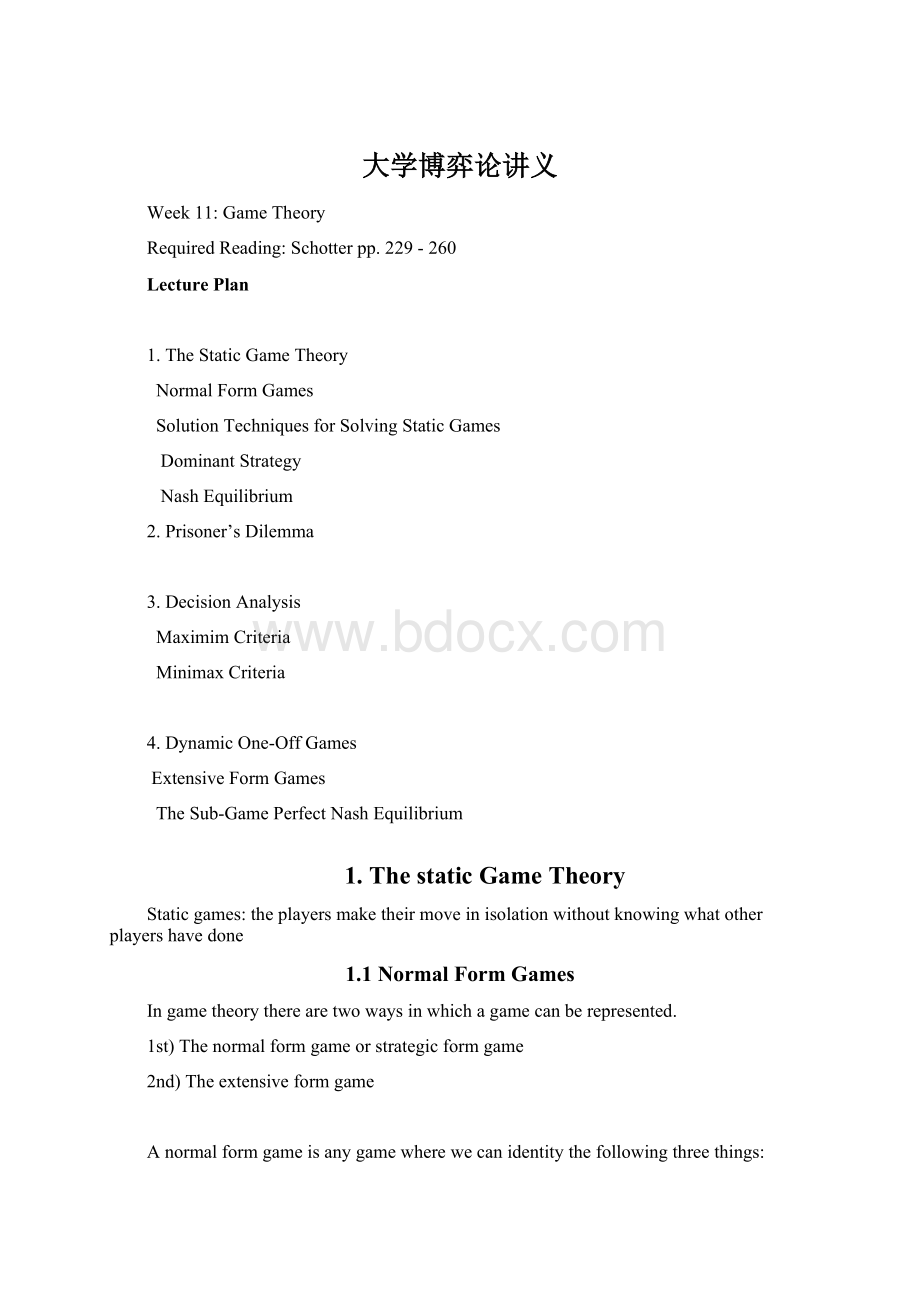 大学博弈论讲义Word下载.docx
大学博弈论讲义Word下载.docx
- 文档编号:21138091
- 上传时间:2023-01-27
- 格式:DOCX
- 页数:8
- 大小:19.01KB
大学博弈论讲义Word下载.docx
《大学博弈论讲义Word下载.docx》由会员分享,可在线阅读,更多相关《大学博弈论讲义Word下载.docx(8页珍藏版)》请在冰豆网上搜索。

3.DecisionAnalysis
MaximimCriteria
MinimaxCriteria
4.DynamicOne-OffGames
ExtensiveFormGames
TheSub-GamePerfectNashEquilibrium
1.ThestaticGameTheory
Staticgames:
theplayersmaketheirmoveinisolationwithoutknowingwhatotherplayershavedone
1.1NormalFormGames
Ingametheorytherearetwowaysinwhichagamecanberepresented.
1st)Thenormalformgameorstrategicformgame
2nd)Theextensiveformgame
Anormalformgameisanygamewherewecanidentitythefollowingthreethings:
1.Players:
2.Thestrategiesavailabletoeachplayer.
3.ThePayoffs.Apayoffiswhataplayerwillreceiveattheendofthegamecontingentupontheactionsofallplayersinthegame.
Supposethattwopeople(AandB)areplayingasimplegame.Awillwriteoneoftwowordsonapieceofpaper,“Top”or“Bottom”.Atthesametime,Bwillindependentlywrite“left”or“right”onapieceofpaper.Aftertheydothis,thepaperswillbeexaminedandtheywillgetthepayoffdepictedinTable1.
Table1
B
A
Left
Right
Top
2,1
0,0
Bottom
1,2
IfAsaystopandBsaysleft,thenweexaminethetop-leftcornerofthematrix.Inthismatrix,thepayofftoA(B)isthefirst(Second)entryinthebox.Forexample,ifAwrites“top”andBwrites“left”payoffofA=1payoffofB=2.
Whatis/aretheequilibriumoutcome(s)ofthisgame?
1.2
NashEquilibriumApproachtoSolvingStaticGames
NashequilibriumisfirstdefinedbyJohnNashin1951basedontheworkofCournotin1893.
ApairofstrategyisNashequilibriumifA'
schoiceisoptimalgivenB'
schoice,andB'
schoiceisoptimalgivenA'
schoice.Whenthisequilibriumoutcomeisreached,neitherindividualwantstochangehisbehaviour.
FindingtheNashequilibriumforanygameinvolvestwostages.
1)identifyeachoptimalstrategyinresponsetowhattheotherplayersmightdo.
GivenBchoosesleft,theoptimalstrategyforAis
GivenBchoosesright,theoptimalstrategyforAis
GivenAchoosestop,theoptimalstrategyforBis
GivenAchoosesbottom,theoptimalstrategyforBis
Weshowthisbyunderlyingthepayoffelementforeachcase.
2)aNashequilibriumisidentifiedwhenallplayersareplayertheiroptimalstrategiessimultaneously
InthecaseofTable2,
IfAchoosestop,thenthebestthingforBtodoistochooseleftsincethepayofftoBfromchoosingleftis1andthepayofffromchoosingrightis0.IfBchoosesleft,thenthebestthingforAtodoistochoosetopasAwillgetapayoffof2ratherthan0.
ThusifAchoosestopBchoosesleft.IfBchoosesleft,Achoosestop.ThereforewehaveaNashequilibrium:
eachpersonismakingoptimalchoice,giventheotherperson'
schoice.
Ifthepayoffmatrixchangesas:
Table2
-6,-6
0,-9
-9,0
-1,-1
thenwhatistheNashequilibrium?
Table3
0,-1
1,0
-1,3
IfthepayoffsarechangedasshowninTable3
2.Prisoners’dilemma
ParetoEfficiency:
AnallocationisParetoefficientifgoodscannotbereallocatedtomakesomeonebetteroffwithoutmakingsomeoneelseworseoff.
Twoprisonerswhowerepartnersinacrimewerebeingquestionedinseparaterooms.Eachprisonerhasachoiceofconfessingtothecrime(implicatingtheother)ordenying.Ifonlyoneconfesses,thenhewouldgofreeandhispartnerwillspend6monthsinprison.Ifbothprisonersdeny,thenbothwouldbeintheprisonfor1month.Ifbothconfess,theywouldbothbeheldforthreemonths.ThepayoffmatrixforthisgameisdepictedinTable4.
Table4
Confess
Deny
Theequilibriumoutcome
LetN=1to4asetofpossiblestatesofnature,andletS=1to4beasetofstrategydecidedbyyou.Nowyouhavetodecidewhichstrategyyouhavetochoosegiventhefollowingpayoffmatrix.
Table5
Nature
S=
1
2
3
4
S=You
N=Opponent
Inthiscaseyoudon'
tcarethepayoffofyouropponenti.e.nature.
3.1TheMaximinDecisionRuleorWaldcriterion
Welookfortheminimumpay-offsineachchoiceandthenmaximisingtheminimumpay-off
Letushighlightthemimimumpayoffforeachstrategy.
3.2TheMinimaxDecisionRuleorSavagecriterion
Onthisruleweneedtocomputethelossesorregretmatrixfromthepayoffmatrix.Thelossesaredefinedasthedifferencebetweentheactualpayoffandwhatthatpayoffwouldhavebeenhadthecorrectstrategybeenchosen.
Regret/Loss=Max.payoffineachcolumn–actualpayoff
ForexampleofN=1occursandS=1ischosen,theactualgain=2fromTable3.However,thebestactiongivenN=1isalsotochooseS=1whichgivesthebestgain=2.For(N=1,S=1)regret=0.
IfN=1occursbutS=2ischosen,theactualgain=1.However,thebestactiongivenN=1isalsotochooseS=1whichgivesthebestgain=2.For(N=1,S=2)regret=2-1.
Followingthesimilaranalysis,wecancomputethelossesforeachNandSandsocancomputetheregretmatrix.
Table6:
RegretMatrix
Maximum
Regret
Aftercomputingtheregretmatrix,welookforthemaximumregretofeachstrategyandthentakingtheminimumofthese.
Minimaxisstillverycautiousbutlesssothanthemaximin.
4.Dynamicone-offGames
Agamecanbedynamicfortworeasons.First,playersmaybeabletoobservetheactionsofotherplayersbeforedecidingupontheiroptimalresponse.Second,one-offgamemayberepeatedanumberoftimes.
4.1ExtensiveFormGames
Dynamicgamescannotberepresentedbypayoffmatriceswehavetouseadecisiontree(extensiveform)torepresentadynamicgame.
Startwiththeconceptofdynamicone-offgamethegamecanbeplayedforonlyonetimebutplayerscanconditiontheiroptimalactionsonwhatotherplayershavedoneinthepast.
Supposethattherearetwofirms(AandB)thatareconsideringwhetherornottoenteranewmarket.Ifbothfirmsenterthemarket,thentheywillmakealossof$10mil.Ifonlyonefirmentersthemarket,itwillearnaprofitof$50mil.SupposealsothatFirmBobserveswhetherFirmAhasenteredthemarketbeforeitdecideswhattodo.
Anyextensiveformgamehasthefollowingfourelementsincommon:
Nodes:
Thisisapositionwheretheplayersmusttakeadecision.Thefirstpositioniscalledtheinitialnode,andeachnodeislabelledsoastoidentifywhoismakingthedecision.
Branches:
Theserepresentthealternativechoicesthatthepersonfacesandsocorrespondtoavailableactions.
PayoffVectors:
Theserepresentthepayoffsforeachplayer,withthepayoffslistedintheorderofplayers.Whenwereachapayoffvectorthegameends.
Inperiod1,FirmAmakesitsdecisions.ThisisobservedbyFirmBwhichdecidestoenterorstayoutofthemarketinperiod2.Inthisextensiveformgame,FirmB’sdecisionnodesarethesub-game.ThismeansthatfirmBobservesFirmA’sactionbeforemakingitsowndecision.
4.2SubgamePerfectNashEquilibrium
SubgameperfectNashequilibriumisthepredictedsolutiontoadynamicone-offgame.Fromtheextensiveformofthisgame,wecanobservethattherearetwosubgames,onestartingfromeachofFirmB’sdecisionnodes.
Howcouldweidentifytheequilibriumoutcomes?
Inapplyingthisprincipletothisdynamicgame,westartwiththelastperiodfirstandworkbackwardthroughsuccessivenodesuntilwereachthebeginningofthegame.
Startwiththelastperiodofthegamefirst,wehavetwonodes.Ateachnode,FirmBdecideswhetherornotenteringthemarketbasedonwhatFirmAhasalreadydone.
Forexample,atthenodeof“FirmAenters”,FirmBwilleithermakealossof–$10mil(ifitenters)orreceive“0”payoff(ifitstaysout);
theseareshownbythepayoffvectors(-10,-10)and(50,0).IfFirmBisrational,itwillstaysout
Thenode“FirmAenters”canbereplacedbythevector(50,0).
Atthesecondnode“FirmAstaysout”,FirmAhasnotenteredthemarket.Thus,FirmBwilleithermakeaprofitof$50mil(ifitenters)orreceive“0”payoff(ifitstaysout);
theseareshownbythepayoffvectors(0,50)and(0,0).IfFirmBisrational,itwillenterthuswecouldruleoutthepossibilityofbothfirmsstayout
Wecannowmovebacktotheinitialnode.HereFirmAhastodecidewhetherornottoenter.IfFirmBisrational,itisknownthatthegamewillneverreachthepreviously“crossed”vectors.FirmAalsoknowsthatifitenters,thegamewilleventuallyendat(Aenters,Bstaysout)whereAgets50andBgets0.Ontheotherhand,ifFirmAstaysout,thegamewillendat(Astaysout,Benters)whereAgets0andBgets50FirmAshouldenterthemarketatthefirststage.Theeventualoutcomeis(Aenters,Bstaysout)
Howtofindasubgameperfectequilibriumofadynamicone-offgame?
1.Startwiththelastperiodofthegamecrossouttheirrelevantpayoffvectors.
2.Replacetheprecedingnodesbytheuncrossedpayoffvectorsuntilyoureachtheinitialnode.
3.Theonlyuncrossedpayoffvector(s)is
- 配套讲稿:
如PPT文件的首页显示word图标,表示该PPT已包含配套word讲稿。双击word图标可打开word文档。
- 特殊限制:
部分文档作品中含有的国旗、国徽等图片,仅作为作品整体效果示例展示,禁止商用。设计者仅对作品中独创性部分享有著作权。
- 关 键 词:
- 大学 博弈论 讲义
 冰豆网所有资源均是用户自行上传分享,仅供网友学习交流,未经上传用户书面授权,请勿作他用。
冰豆网所有资源均是用户自行上传分享,仅供网友学习交流,未经上传用户书面授权,请勿作他用。


 铝散热器项目年度预算报告.docx
铝散热器项目年度预算报告.docx
